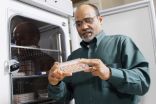(Press-News.org) WEST LAFAYETTE, Ind. - Pathogenic listeria tricks intestinal cells into helping it pass through those cells to make people ill, and, if that doesn't work, the bacteria simply goes around the cells, according to a Purdue University study.
Arun Bhunia, a professor of food science, and Kristin Burkholder, a former Purdue graduate student who is now a postdoctoral researcher in microbiology and immunology at the University of Michigan Medical School, found that listeria, even in low doses, somehow triggers intestinal cells to express a new protein, heat shock protein 60, that acts as a receptor for listeria. This may allow the bacteria to enter the cells in the intestinal wall and exit into a person's bloodstream. Bhunia and Burkholder's findings were published in the early online version of the journal Infection and Immunity.
"It's possible that host cells generate more of these proteins in order to protect themselves during a stressful event such as infection," Burkholder said. "Our data suggest that listeria may benefit from this by actually using those proteins as receptors to enhance infection."
Listeria monocytogenes is a foodborne bacteria that can cause fever, muscle aches, nausea and diarrhea, as well as headaches, stiff neck, confusion, loss of balance and convulsions if it spreads to the nervous system. According to the U.S. Centers for Disease Control and Prevention, it sickens about 2,500 and kills 500 people each year in the United States and primarily affects pregnant women, newborns, older adults and those with weakened immune systems.
The findings suggest that listeria may pass between intestinal cells to sort of seep out of the intestines and into the bloodstream to cause infection.
"That can expedite the infection," Bhunia said.
Measurable increases of the heat shock 60 protein were detected when listeria was introduced to cultured intestinal cells.
Bhunia and Burkholder also introduced listeria to intestinal cells in the upper half of a dual-chamber container and counted the number of bacteria that passed through the cells and appeared in the lower chamber.
The bacteria moved to the lower chamber faster than it is known to do when moving through cells, and did so even when a mutant form of the bacteria that do not invade the intestinal cells was used. This suggests the bacteria are moving around the cells, Bhunia said.
"The infective dose is very low. Even 100 to 1,000 listeria cells can cause infection," Bhunia said. "We believe that these mechanisms are what allow listeria to cause infections at such low levels."
Bhunia said he next would try to understand how listeria and the heat shock 60 protein interact and work to develop methods to protect intestinal cells from the bacteria. The Center for Food Safety Engineering at Purdue funded part of the research.
INFORMATION:
Writer: Brian Wallheimer, 765-496-2050, bwallhei@purdue.edu
Sources: Arun Bhunia, 765-494-5443, bhunia@purdue.edu
Kristin Burkholder, 734-763-5639, kburkhol@umich.edu
PHOTO CAPTION:
Arun Bhunia determined that listeria bacteria can pass between intestinal cells and triggers a mechanism that increases listeria's ability to enter the cells. (Purdue Agricultural Communication photo/Tom Campbell)
A publication-quality photo is available at http://news.uns.purdue.edu/images/2010/bhunia-listeria.jpg
Abstract on the research in this release is available at: http://www.purdue.edu/newsroom/research/2010/101025BhuniaListeria.html
Listeria clever at finding its way into bloodstream, causing sickness
2010-10-26
ELSE PRESS RELEASES FROM THIS DATE:
Modern humans emerged far earlier than previously thought
2010-10-26
An international team of researchers based at the Institute of Vertebrate Paleontology and Paleoanthropology in Beijing, including a physical anthropology professor at Washington University in St. Louis, has discovered well-dated human fossils in southern China that markedly change anthropologists perceptions of the emergence of modern humans in the eastern Old World.
The research was published Oct. 25 in the online early edition of the Proceedings of the National Academy of Sciences.
The discovery of early modern human fossil remains in the Zhirendong (Zhiren Cave) ...
'Fracking' mobilizes uranium in marcellus shale
2010-10-26
BUFFALO, N.Y. -- Scientific and political disputes over drilling Marcellus shale for natural gas have focused primarily on the environmental effects of pumping millions of gallons of water and chemicals deep underground to blast through rocks to release the natural gas.
But University at Buffalo researchers have now found that that process -- called hydraulic fracturing or "fracking"-- also causes uranium that is naturally trapped inside Marcellus shale to be released, raising additional environmental concerns.
The research will be presented at the annual meeting of ...
Study finds race, ethnicity impact access to care for children with frequent ear infections
2010-10-26
Ear infections are one of the most common health problems for children, with most kids experiencing at least one by their third birthday. Annual costs in the United States alone are in the billions of dollars.
When these infections are left untreated, complications can include hearing loss, speech problems and more severe infections that can spread to bone and brain, causing meningitis. But not all kids have the same access to medical specialists and medicines.
A new study by researchers at the David Geffen School of Medicine at UCLA and Harvard Medical School has ...
Knowledge gaps, fears common among parents of children with drug-resistant bacteria
2010-10-26
Knowledge gaps and fear — some of it unjustified — are common among the caregivers of children with a drug-resistant staph bacterium known as MRSA, according to the results of a small study from the Johns Hopkins Children Center. These caregivers thirst for timely, detailed and simple information, the researchers add.
The study's findings, published online in The Journal of Pediatrics, underscore the need for healthcare staff to do a better job in educating parents, while also addressing concerns and allaying fears, the investigators say.
"What these results really ...
Growing crops in the city
2010-10-26
Madison, WI, October 25, 2010 – A case study published in the 2010 Journal of Natural Resources and Life Sciences Education by professors at Washington State University studies the challenges one organization faced in maintaining an urban market garden. The journal is published by the American Society of Agronomy.
Since 1995, Seattle Youth Garden Works (SYGW) has employed young homeless individuals or those involved in the juvenile justice system. SYGW offers teens and young adults the opportunity to work, develop social skills, and eventually find stable employment or ...
Newfoundland researchers crack the genetic code of a sudden death cardiac killer
2010-10-26
Montreal – Researchers in Newfoundland have cracked the genetic code of a sudden death cardiac killer.
As a result, they have developed a unique prevention program in which people with no symptoms, but with a suspect gene and a family history, are being implanted with internal cardiac defibrillators (ICDs) which can restart their hearts if they stop.
"Our discovery has led to a targeted genetic screening and individualized therapy that is significantly improving survival rates," Dr. Sean Connors told the Canadian Cardiovascular Congress 2010, co-hosted by the Heart ...
Cardiac wakeup call for Canadian kids
2010-10-26
"Sleep disorders in kids are on the increase. They are marching hand in hand with other increasing cardiovascular risk factors such as overweight and obesity, lack of physical activity, a poor diet, and high levels of unhealthy cholesterol," Dr. McCrindle today told the Canadian Cardiovascular Congress 2010, co-hosted by the Heart and Stroke Foundation and the Canadian Cardiovascular Society.
"Teens who experience more disordered sleep − in terms of duration, quality, and pattern − have a higher body mass index and a correspondingly higher risk of overweight ...
DGAC report offers food and nutrition practitioners insights on helping combat obesity epidemic
2010-10-26
St. Louis, MO, October 26, 2010 – In an insightful Commentary in the November issue of the Journal of the American Dietetic Association, Linda Van Horn, PhD, RD, Editor-in-Chief of the Journal, Chair of the Dietary Guidelines Advisory Committee, and Professor and Associate Dean, Northwestern University, Feinberg School of Medicine, highlights the key features and noteworthy findings of the 2010 US Dietary Guidelines Advisory Committee (DGAC) Report. While many of the recommendations from previous reports are reinforced, new evidence-based findings will help registered dietitians ...
Consuming polyunsaturated fatty acids may lower the incidence of gum disease
2010-10-26
St. Louis, MO, October 26, 2010 – Periodontitis, a common inflammatory disease in which gum tissue separates from teeth, leads to accumulation of bacteria and potential bone and tooth loss. Although traditional treatments concentrate on the bacterial infection, more recent strategies target the inflammatory response. In an article in the November issue of the Journal of the American Dietetic Association, researchers from Harvard Medical School and Harvard School of Public Health found that dietary intake of polyunsaturated fatty acids (PUFAs) like fish oil, known to have ...
Emerging Company To Make Awareness Fashionable Through Genetic Art
2010-10-26
( http://www.inourgenes.com/ ) In Our Genes (IOG) is the first genetic-art clothing line for the mass market; a green line of apparel featuring genetically rendered DNA prints of some of the most challenging diseases. The branded apparel comes with a charitable tie in, making IOG the frontrunner in fighting, managing and eliminating our most notorious ailments by combining science, fashion and compassion.
SCIENCE: Dubbed the founding father of genetic art by Newsweek magazine, In Our Genes founder Darrin Grandmason idealized a product that puts substance behind style. ...

